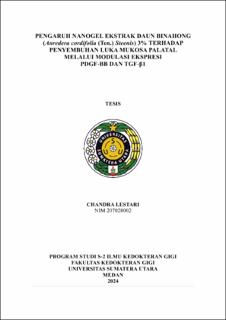| dc.description.abstract | Background: Palatal wounds are difficult to repair due to the frequency of failure during the healing process, which is characterized by pain, infection, scarring, and unwanted adhesions and often occurs in poor oral cavity environment. Fibroblasts secrete several cytokines, growth factors, and extracellular matrix, including transforming growth factor beta (TGF-β) and platelet-derived growth factor (PDGF) during tissue repair and reconstruction, which can accelerate wound healing. Drugs or advanced treatment has some limitations such as resistance and high costs in treating wounds. The use of binahong leaf extract, which is known to contain chemical compounds, namely tannins, saponins, alkaloids, flavonoids, and ascorbic acid with pharmacological properties, such as anti-inflammatory, antibacterial, antifungal, antiviral, and antioxidant, has started to be developed. Purposes: This in vivo research assessed the effect of administering 3% binahong leaf extract nanogel on the expression of PDGF-BB and TGF-β1 as markers of fibroblast cell proliferation during the healing process of palatal mucosal wound. Methods: A total of 24 male Wistar rats were given 4 mm wide wounds on the palatal mucosa and divided into 2 groups, those receiving 3% binahong leaf extract nanogel and nanogel base, respectively. The number of fibroblast cells, PDGF-BB, and TGF-β1 expression were observed using palatal tissue taken on days 3, 7, and 14, assessed histologically and using immunohistochemistry. Normality and homogeneity tests were carried out, then followed by one-way ANOVA and post-hoc LSD tests. Data that was not normally distributed or non homogeneous were assessed using the Kruskal-Wallis and Mann-Whitney tests. PDGF-BB and TGF-β1 expression were tested by chi-square. Results: There was a significant difference in the mean number of fibroblast cells (p≤0.05) between groups on days 3, 7, and 14. No significance were seen in PDGF-BB expression (p>0.05) during all observations, although treatment groups showed better results on day 7. There was a significant difference in TGF-β1 expression between groups only on day 3 (p≤0.05). Conclusion: Administration of 3% binahong leaf extract nanogel has an effect on the wound-healing process of palatal mucosa in Wistar rats at both cellular and molecular levels. | en_US |


